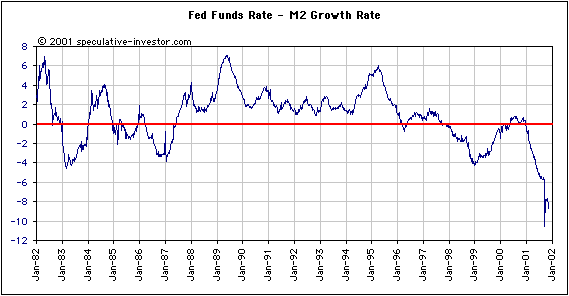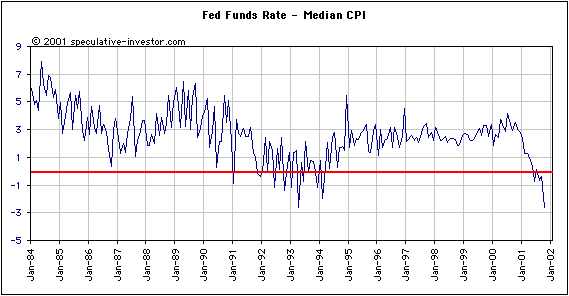
The 'Real'
Real Interest Rate
The Economic Cycle Research Institute
(ECRI) calculates a Future Inflation Gauge (FIG) each month. As its name
suggests the FIG was designed to predict changes in the inflation rate
with a lead-time of several months. However, neither the money supply growth
rate nor the single most important influence on the money supply growth
rate - changes in the level of long-term interest rates - are considered
when calculating the FIG. It is therefore not a good leading indicator
of inflation (a list of the FIG's components can be found at http://www.dismal.com/dismal/dsp/release_def.asp?r=usa_ecrifig).
As the following chart shows it has, however, been an excellent leading
indicator of Fed policy during Greenspan's tenure as Fed Chairman (the
chart was taken from the ECRI's web site). In our opinion the FIG should
be re-named the FGG - Future Greenspan Gauge.
Since 1934 the US has experienced inflation,
and only inflation, in varying degrees. During those times when the inflation
manifested itself in the prices of commodities and the widely-watched (and
manipulated far beyond the point of usefulness) price indices, the inflation
was perceived to be a problem. During those times when the inflation was
only evident in the trade deficit and/or asset prices, the inflation wasn't
perceived to be a problem. In fact it wasn't (isn't) perceived at all.
Our view of inflation/deflation - that
inflation is an increase in the money supply and deflation is a decrease
in the money supply - may appear to be overly simplistic. However, it is
only by starting with the premise that inflation/deflation relate purely
to what is happening with the supply of money that One can make sense of
what has happened over the past decade.
Asset price bubbles can only occur
when the real rate of interest (the nominal interest rate minus the inflation
rate) is extremely low. However, during 1996-1999 anyone who calculated
the real interest rate by subtracting the CPI from the nominal interest
rate would not have perceived that real interest rates were unusually low.
They would therefore, in all likelihood, have found the need to resort
to "new era" and "new economy" fantasies in order to explain the asset
price explosion. For those who understood the true meaning of inflation
the explanation was far more logical - negative real interest rates propelled
a massive expansion of credit that, in turn, pushed asset prices and the
trade deficit into the stratosphere.
Below are two charts that illustrate
our point. The first chart shows the real Fed Funds Rate calculated by
subtracting the year-over-year change in M2 money supply from the Fed Funds
Rate (let's call this the 'real' real interest rate). Note that the 'real'
real interest rate peaked in early 1995 at 6%, went decisively negative
in late-1997 and didn't turn positive again until the first half of 2000.
Recall what happened to the stock market when the 'real' real interest
rate poked its head above zero last year. The second chart shows the real
Fed Funds Rate calculated by subtracting the annualised percentage change
in the median CPI from the Fed Funds Rate and represents the consensus
view of the real interest rate. (The median CPI, calculated monthly by
the Cleveland Fed, is the best official measure of consumer price changes
because any outlying values are excluded from its calculation. For example,
if tobacco prices spike higher and computer prices spike lower during a
particular month then both will be excluded from that month's calculation.)
Note that this real interest rate remained stable in the +2.5% to +3.5%
range throughout the course of the asset price bubble.


The above charts also confirm that
both the real interest rate and the 'real' real interest rate are now extremely
low (deeply into negative territory). The conditions are currently very
much in place for another bubble with the big question being where
the next bubble will appear.
The US is presently experiencing an
extremely high inflation rate and extremely low real interest rates, yet
the Future Greenspan Gauge tells us not to expect any change in Fed policy
for at least a few more months. This means the inflation problem is going
to get much worse.
Regular financial market forecasts
and
analyses are provided at our web site:
http://www.speculative-investor.com/new/index.html
One-month free trial available.

|

